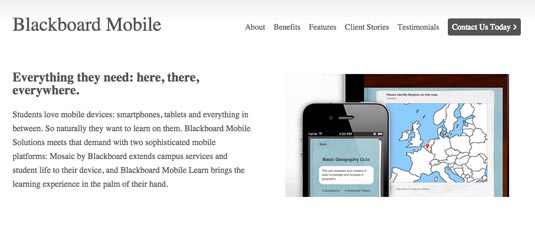How to put empathy at the core of the design process
Understanding people's needs is at the core of design, says Jon Kolko.
A traditional approach to enterprise software is based on requirements: a customer defines a set of functional requirements, a software provider builds to this specification, and the product ships.
When another customer purchases the software, they have some unique requirements of their own, and these are added. Over time, the software grows to be what is nicely called "feature rich" and what is not so nicely referred to as "bloated."
Blackboard has followed a requirement-driven process for years, and it's helped the company solidify a role as the biggest and most adopted virtual learning environment in the world.
But our cultural view of software has changed, and simple tools like Harvest, Dropbox, Instagram and Facebook have shifted our expectations of how software should look, feel and function.
The notion of "enterprise software" – software that's defined and driven by a large customer – is dated. Users expect software to fit seamlessly into their lives, and see no real distinction between software they use at work and software they use in their personal life.
Empathy-led
Given this shift, Blackboard has taken on a massive overhaul of our products. We're transitioning from a "requirement-led" process to an "empathy-led" process.

Rather than building software specified by an administrator or a CIO, we're building software for teachers and students – our end users. And in this new process, we try to feel what it's like to be a teacher or a student, and leverage this empathy to create products people love.
Daily design news, reviews, how-tos and more, as picked by the editors.
Our process looks like this:
- We conduct qualitative, behavioural research with teachers and students. We spend time with them in their classrooms, in their dorm rooms, and watch them do the things that they think are important. For an instructor, this might mean preparing a lesson, meeting with students or other instructors, planning research or teaching a course. For a student, this might mean hanging with their friends, doing their course work or registering for classes. The key is to watch behaviour, rather than engage in an interview or a questionnaire.
- Next, we translate this behaviour into insights – provocative statements of truth. We make inferences about what we saw, asking why. And we answer this why question, even if we don't know the answer for sure. Our answers often describe cultural pressures, rather than utilitarian needs. For example, why does a student who is borrowing thousands of pounds for university skip classes and watch YouTube lectures? Our answer might be: Students don't feel the immediate weight of college tuition because they won't have to start paying until they graduate and reach a certain income level, and so they treat their education as if it were free. This is obviously not true for all students, but we'll make the statement as if it were.

- These insights now describe the different capabilities we'll include in our software. If we assert that students don't realise how much money they are wasting, we can build tools that better visualise the cost of education in real time rather than a future debt.
- Because we're focusing on emotional and cultural problems, our solutions need to provide emotional or cultural value, and this changes the way we think about what software does and how it works.
Into practice
Following this process is rather straightforward. But driving it into an organisation is difficult – watch people and infer what makes them do the things they do.
But this inference adds risk into the process. The focus on emotions is not analytical and can offer counter-intuitive findings. And the focus on people that use the software rather than people that will pay for the software can be difficult for a business to accept.
The process leads to products that are more meaningful, more focused and more valuable to the people that have to use them. The process is strategic, but at Blackboard, the output of the process is highly visual. Here are some of the changes we're bringing to market, driven by this process.
Words: Jon Kolko
Jon Kolko is vice president of Design at Blackboard; he joined Blackboard with the acquisition of MyEdu, a startup focused on helping students succeed in college and get jobs. He is also the founder and director of Austin Center for Design.
Like this? Read these!
- 10 buzzwords every designer should know
- Discover the best blogging platform
- The best free script fonts

The Creative Bloq team is made up of a group of art and design enthusiasts, and has changed and evolved since Creative Bloq began back in 2012. The current website team consists of eight full-time members of staff: Editor Georgia Coggan, Deputy Editor Rosie Hilder, Ecommerce Editor Beren Neale, Senior News Editor Daniel Piper, Editor, Digital Art and 3D Ian Dean, Tech Reviews Editor Erlingur Einarsson, Ecommerce Writer Beth Nicholls and Staff Writer Natalie Fear, as well as a roster of freelancers from around the world. The ImagineFX magazine team also pitch in, ensuring that content from leading digital art publication ImagineFX is represented on Creative Bloq.
